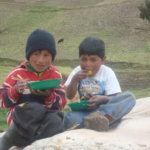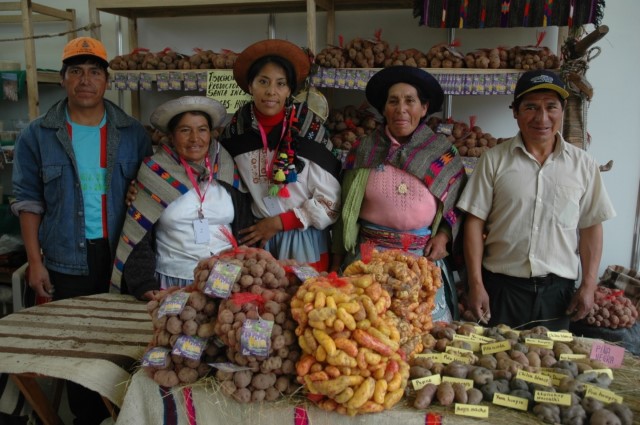


Grupo Yanapai
INN, CIP
Ecuador, Bolivia, and Peru
8/2009—8/2013
The Chopcca communities are a Quechua-speaking indigenous group located in the highlands (3500-4500 meters above sea level ) around Huancavelica, Peru. Chopcca communities farm at high altitudes and are susceptible to frost that can wipe out the majority of a harvest in one night. The staple crop in the region is native potato, but yields are low and the biodiversity that is essential to providing resilience is eroding due to factors such as markets and migration. The nutrition in the area is very poor due to the starch-based diet.
The first phase of this project focused on reintroducing native potato varieties and valuing agrobiodiversity, agronomic factors such as virus and pest production and animal issues and health. Based on lessons learned during the first four years of CCRP financing, Yanapai proposed to shift its focus from soils and biodiversity to nutrition and agrobiodiversity. They have chosen the entry point of nutrition because of the high levels of malnutrition and stunting among women and children in the area due to insufficient quality and quantity.
Their main areas of intervention included working with women on small animal raising and home gardens. Specifically, the project studied the causes of malnutrition (including diseases, education and cultural values) and provide tools for improving food security through gardens and small animals.
Potato virus load showed that it might not be as big a problem as previously thought. Research on direct seeding vs. transplanting for home gardens shows that direct seeding is more efficient and productive. Preliminary analysis of baseline data shows no or very weak relationship between biodiversity conservation and nutrition, however might be using a weak biodiversity indicator. Also demonstrates that there is not a relationship between size of farm and nutrition. And the nutrition baseline indicated that animal food is necessary, iron and calcium are most lacking in the diet and infectious disease might be principal problem affecting the nutrition of children under five .
A final qualitative evaluation was done using group interviews/ discussion (2 in each community divided by gender in the 4 communities the project worked, total 90 informants) mostly with community leaders who had a high participation in the project activities. The results show that the informants highly value Yanapai in contrast to other NGOs for their long term commitment, presence in the zone and ability to communicate in quechua. In terms of production the greatest impacts of Yanapai identified were:
1) pest control, introduction of new varieties of potato and lupin, which helped them improve both their consumption as well as sale in the market.
2) introduction and spread of cultivated pastures and animal raising which led to higher productivity and food availability, including helping with chickens who were well adapted to the altitude and now provide them with a regular source of eggs
3) introduction and spread of family gardens for vegetable production.A final qualitative evaluation was done using group interviews/ discussion (2 in each community divided by gender in the 4 communities the project worked, total 90 informants) mostly with community leaders who had a high participation in the project activities.
The main achievements that the informants report for nutrition are:
1) they now prioritize child feeding instead of parents and give them foods specially prepared for small children
2) they don’t sell eggs and milk as much, save the majority for children’s food
3) there is now interest in preparing a balanced diet complementing traditional foods with vegetables, milk and eggs
4) there is a tendency to buy nutritious foods (fruit, vegetables, fish).
A final qualitative evaluation was done using group interviews/ discussion (2 in each community divided by gender in the 4 communities the project worked, total 90 informants) mostly with community leaders who had a high participation in the project activities there was also a survey of of all parents who had children less than 3 years old (n=585 in 2014) The survey results showed that only 3% of men participated frequently and 30% did not participate at all while 24% of women participated frequently and 24% did not participate at all. However, the informants said that many villagers would just ask the field technicians (who lived in one of the villages) for advice when they needed it. The key informants said they really appreciated the potato seed and experimentation in their fields and they like that the project supported their custom of mixed varieties to have a diversity of flavors. They also noted a change in perception about their future in terms of what is possible for their children to study and progress based partly on the example of the Yanapai technicians and the exchange visits Yanapai organized with other communities.
To address the lack of potato seed, multiplication of high micronutrient content potatoes took place within 14 women´s for a total of 2,907kg of potato seed grown in a total of 0.5ha seed plots and 4, 845.0kg grown and managed by Yanapai. This seed was distributed to a total of 323 families at a rate of 24 kg/woman in 4 intervention communities. In the 2014- 2015 growing season these were grown across 5.9 has. Seed distributed during the years of selection has allowed 44% of Chopcca families to plant and consume small (still not enough to effect overall nutrition) quantities of high nutrient content potatoes. It is expected for the 2015-16 growing season an increment and diffusion of these throughout the community.To encourage more widespread impact of projects results and learning, a field day was held that incorporated both project farmers, farmers from another, far off community and local authorities, in total there were 250 participants, mostly women, who learned about their advances in IPM, participatory selection of potatoes, fodder and small animal raising, child nutrition, and high nutritional content potatoes.
According to baseline (n=181) and endline (n=271) surveys, four communities that participated in an participatory research on potato disease and pest management lowered their reported percentage of losses due to Andean Weevil from 80% to 26%; for late blight from 47% to 15% and for rotting from 41% to 10%. Key informants (n=90) provided extensive detail about how Yanapai helped them with weevil control including a competition to collect weevils. Perhaps partially due to these decreases in P&D, potato yields increased from 0.52 kilos/ m2 in 2010 to 2.5 in 2014 and native potato yield increased from 0.34 to 0.5, fava beans and oca also had impressive increases. Farmer informants from the 4 communities in discussion groups (n=90) confirmed this data saying they now have much more production with which to feed their family and sell. This is also reflected in the total average potato yield increasing for improved and native potatoes as well as newly introduced high nutrition content potatoes for a total average change from 763 kilos/ year to 1187.
It was shown that sheep manure compost tea improved potato harvests to 21 tons/ hectare over the control of just water (16 tn/ hectare) and chemical foliar fertilizer (19 tn/ hectare) using randomized block trials.
Farmers experimented with growing seed of improved forage oats (Mantaro 15M) that yields 30% more than local oat varieties over 3800 masl. INIA (NARC) said it can only produce seed up to 3500 masl. 800 kg of seed were produced between 2 communities above 3800 masl. Thus we see how local adaptation and farmer experimentation can lead to new technologies and practices.Starting in 2011 5 chickens each were distributed to 210 women through 14 women’s associations In the beginning of the program there was a lot of chicken mortality that also seems to be decreasing due to training efforts. As of 2013 50% of the women continue to use the profits from selling chickens to replenish their stock. Every 5 chickens provides 5.7 kilos of meat and 79 eggs per year.In a campaign to educate high school boys and girls about nutrition in 4 of the intervention communities, the project reached 150 students. Their knowledge scores went from an average of 40% to 75% before and after the trainings.
In a nutrition baseline of 4 highland communities with a representative sample of 182 households, agrobiodiveristy was not associated with food security in this population and did not protect against low dietary intakes of essential micronutrients. Intake of animal protein was the main determinant of dietary quality and raising small animals seemed to protect against food security.
Of 167 families that participated in FFS in 2006 around forage management (2 new improved varieties), a follow up survey reveals 25% bought seed to increase pasture, 45% spent money for fencing, 80% invested in irrigation and 100% said they increased cows and cuyes by 65% due to pasture. While families are not incorporating guinea pigs is regular diet, 678 were eaten during 15 wedding celebrations in June 2012. It is possible that this intervention resulted in more milk production from the cattle that led to milk availability for the children.TIPS: 49 families were visited. Around 30% had added important foods to their children’s diets like fava beans, eggs, cheese and meat one week later. The project has also worked explicitly to increase availability of these products.
Research using a representative samples of 4 communities in highland Peru (Huancavelica) shows that there is not a relationship between size of farm and nutrition. Main nutritional deficits are Iron, Zinc, Ca and folic acid, which can be remedied with legumes, animal products, fruits and green vegetables. Infectious disease might be principal problem. Children nutrition better at times of scarcity because of bought foods and supplements.
According to a mixed methods study done in Peru of 336 farmers and 29 institutions, using SNA, qualitative and geographic analysis, in one region (Pasco) the commercial articulation of native-floury and bred-improved potatoes with markets and historical antecedents of late blight has deeply internalized the regular use of agricultural inputs. In the other region (Huancavelica), late blight is a recent phenomenon that may expose native potato adaptations and smallholder livelihoods in that particular domain or “hotspot” to future pressures and unprecedented risk, which includes the use of fungicides with detrimental effects on human health and the soil matrix. Future areas of research should contemplate the appearance of highly resistant P. infestans strains and on-farm and community-level coping strategies that control spread of the disease with minimal use of synthetic inputs, through participatory on-farm trials of native and hybrid clones resistant to late blight. The impacts of seed degeneration on current yield performance and an integrated seed health strategy would also be highly beneficial to smallholders and agricultural development in Peruvian society at large.According to 225 endline (2013) 24 hour recalls and that encompassed the entire universe of children between 6 months and 3 years in the 5 communities of intervention in Choppca, Peru (same method as baseline- 2011). The children of families who participated in the activities of Yanapai consumed more legumes (36% vs 26%) than the families who did not participate. Other than that, it was confirmed that protein, energy and frequency of feedings were not a problem before or after the intervention. Conversely micronutrient deficiencies continued to be a problem before and after, with some numbers going up, some going down, but no real patterns emerging. This was probably influenced with external factors like distribution of biofortificated food by other govt. agencies and the short time frame. No obvious gains were made from biofortificated potatoes and increased animal product consumption that the project was promoting.
A study of the production outputs of 165 households in 4 communities of highland Peru found that 59% of them could theoretically meet their household food needs for energy, iron and zinc. Livestock did not make a significant contribution to meeting these needs. The strongest difference between those who could theoretically meet their nutrition needs through their own production and those who could not was per capital cropping land size. Modeling showed that increasing potato production was the biggest lever of change for meeting needs through self-production.
